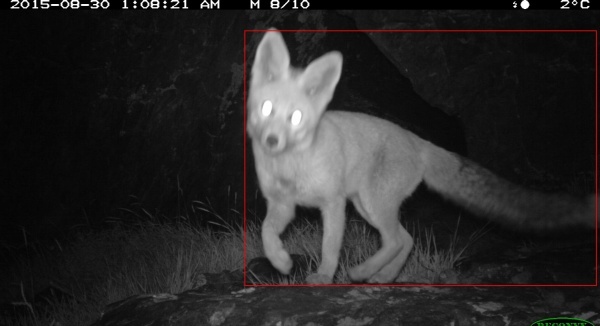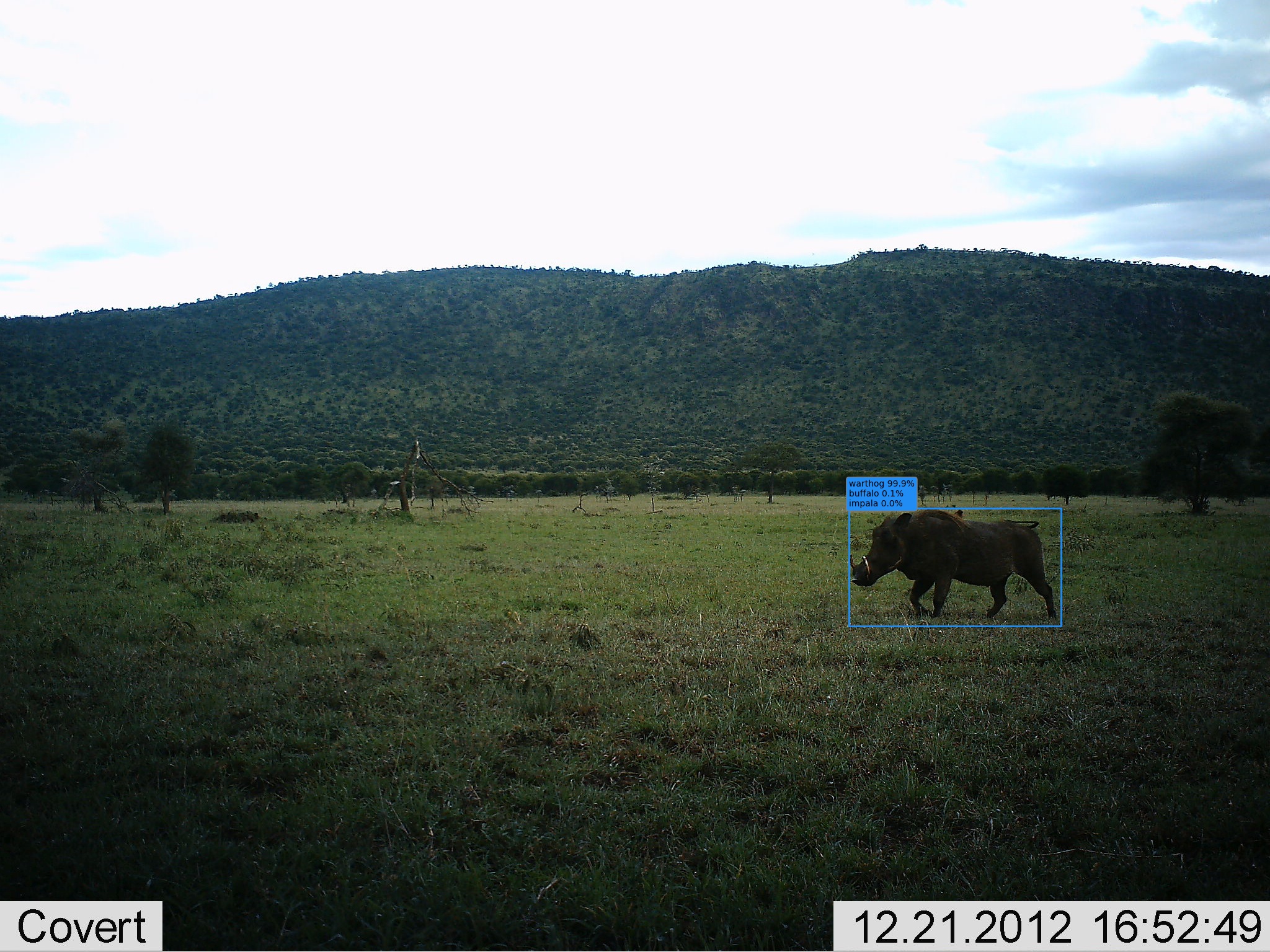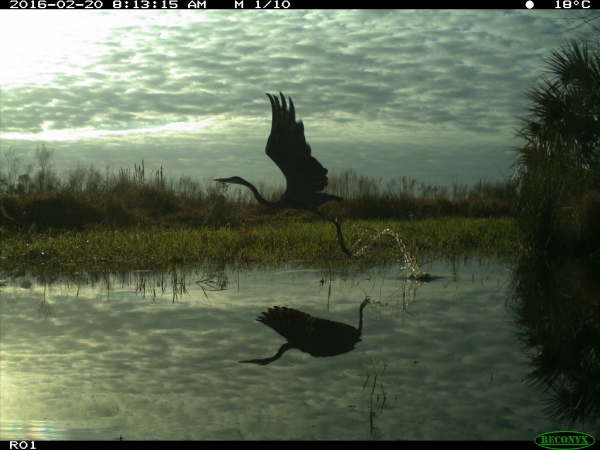...helping conservation biologists spend less time doing boring things with camera trap images.
- Repo overview
- What's MegaDetector all about?
- How do I get started with MegaDetector?
- Who is using MegaDetector?
- Repo contents
- Contact
- Gratuitous camera trap picture
This repo contains the tools for training and running MegaDetector, an object detection model that does a pretty good job finding animals, people, and vehicles (and therefore is pretty good at finding empty images) in camera trap images in a variety of terrestrial ecosystems.
The core functionality provided is:
- Training and running MegaDetector.
- Training and running some species classifiers that are used in conjunction with MegaDetector.
- Tools to convert frequently-used camera trap metadata formats into a common format.
- A batch processing API that runs MegaDetector on large image collections, to accelerate population surveys.
- A real-time API that runs MegaDetector (and some species classifiers) synchronously, primarily to support biosecurity applications.
MegaDetector was initially developed by the Microsoft AI for Earth program; this repo was forked from the microsoft/cameratraps repo and is maintained by the original MegaDetector developers (who are no longer at Microsoft, but are absolutely fantastically eternally grateful to Microsoft for the investment and commitment that made MegaDetector happen).
MegaDetector is an object detection model that identifies animals, people, and vehicles in camera trap images (which also makes it useful for eliminating blank images). This model is trained on several hundred thousand bounding boxes from a variety of ecosystems. Lots more information – including download links and instructions for running the model – is available in the MegaDetector User Guide.
This repo does not host the data used to train MegaDetector, but we work with our collaborators to make data and annotations available whenever possible on lila.science. See the MegaDetector training data section to learn more about the data used to train MegaDetector.
Here's a “teaser” image of what MegaDetector output looks like:

Image credit University of Washington.
If you're just considering the use of AI in your workflow, and you aren't even sure yet whether MegaDetector would be useful to you, we recommend reading the "getting started with MegaDetector" page.
If you're already familiar with MegaDetector and you're ready to run it on your data (and you have some familiarity with running Python code), see the MegaDetector User Guide for instructions on downloading and running MegaDetector.
If you're a programmer-type looking to use tools from this repo, we generally recommend cloning the repo, but there is also a Python package that provides access to everything in this repo (yes, you guessed it, "pip install megadetector").
MegaDetector is just one of many tools that aims to make conservation biologists more efficient with AI. If you want to learn about other ways to use AI to accelerate camera trap workflows, check out our of the field, affectionately titled “Everything I know about machine learning and camera traps”.
We work with ecologists all over the world to help them spend less time annotating images and more time thinking about conservation. You can read a little more about how this works on our getting started with MegaDetector page.
Here are a few of the organizations that have used MegaDetector... we're only listing organizations who (a) we know about and (b) have given us permission to refer to them here (or have posted publicly about their use of MegaDetector), so if you're using MegaDetector or other tools from this repo and would like to be added to this list, email us!
-
Canadian Parks and Wilderness Society (CPAWS) Northern Alberta Chapter
-
Applied Conservation Macro Ecology Lab, University of Victoria
-
Banff National Park Resource Conservation, Parks Canada
-
Blumstein Lab, UCLA
-
Borderlands Research Institute, Sul Ross State University
-
Capitol Reef National Park / Utah Valley University
-
Center for Biodiversity and Conservation, American Museum of Natural History
-
Centre for Ecosystem Science, UNSW Sydney
-
Cross-Cultural Ecology Lab, Macquarie University
-
DC Cat Count, led by the Humane Rescue Alliance
-
Department of Fish and Wildlife Sciences, University of Idaho
-
Department of Wildlife Ecology and Conservation, University of Florida
-
Ecology and Conservation of Amazonian Vertebrates Research Group, Federal University of Amapá
-
Gola Forest Programma, Royal Society for the Protection of Birds (RSPB)
-
Graeme Shannon's Research Group, Bangor University
-
Hamaarag, The Steinhardt Museum of Natural History, Tel Aviv University
-
Institut des Science de la Forêt Tempérée (ISFORT), Université du Québec en Outaouais
-
Lab of Dr. Bilal Habib, the Wildlife Institute of India
-
Mammal Spatial Ecology and Conservation Lab, Washington State University
-
McLoughlin Lab in Population Ecology, University of Saskatchewan
-
National Wildlife Refuge System, Southwest Region, U.S. Fish & Wildlife Service
-
Northern Great Plains Program, Smithsonian
-
Polar Ecology Group, University of Gdansk
-
Quantitative Ecology Lab, University of Washington
-
Santa Monica Mountains Recreation Area, National Park Service
-
Seattle Urban Carnivore Project, Woodland Park Zoo
-
Serra dos Órgãos National Park, ICMBio
-
Snapshot USA, Smithsonian
-
Wildlife Coexistence Lab, University of British Columbia
-
Wildlife Research, Oregon Department of Fish and Wildlife
-
Wildlife Division, Michigan Department of Natural Resources
-
Department of Ecology, TU Berlin
-
Ghost Cat Analytics
-
Protected Areas Unit, Canadian Wildlife Service
-
School of Natural Sciences, University of Tasmania (story)
-
Kenai National Wildlife Refuge, U.S. Fish & Wildlife Service (story)
-
Australian Wildlife Conservancy (blog posts 1, 2)
-
Alberta Biodiversity Monitoring Institute (ABMI) (WildTrax platform) (blog posts 1,2)
-
Shan Shui Conservation Center (blog post) (translated blog post) (Web demo)
-
Road Ecology Center, University of California, Davis (Wildlife Observer Network platform)
Also see:
-
The list of MD-related GUIs, platforms, and GitHub repos within the MegaDetector User Guide
-
Peter's map of EcoAssist users (who are also MegaDetector users!)
-
The list of papers tagged "MegaDetector" on our list of papers about ML and camera traps
This repo is organized into the following folders...
Code for hosting our models as an API, either for synchronous operation (i.e., for real-time inference) or as a batch process (for large biodiversity surveys). Common operations one might do after running MegaDetector – e.g. generating preview pages to summarize your results, separating images into different folders based on AI results, or converting results to a different format – also live in this folder, within the api/batch_processing/postprocessing folder.
Old code that we didn't quite want to delete, but is basically obsolete.
Experimental code for training species classifiers on new data sets, generally trained on MegaDetector crops. Currently the main pipeline described in this folder relies on a large database of labeled images that is not publicly available; therefore, this folder is not yet set up to facilitate training of your own classifiers. However, it is useful for users of the classifiers that we train, and contains some useful starting points if you are going to take a "DIY" approach to training classifiers on cropped images.
All that said, here's another "teaser image" of what you get at the end of training and running a classifier:

Image credit University of Minnesota, from the Snapshot Safari program.
Code for:
- Converting frequently-used metadata formats to COCO Camera Traps format
- Converting the output of AI models (especially YOLOv5) to the format used for AI results throughout this repo
- Creating, visualizing, and editing COCO Camera Traps .json databases
Code for training, running, and evaluating MegaDetector.
Environment files... specifically .yml files for mamba/conda environments (these are what we recommend in our MegaDetector User Guide), and a requirements.txt for the pip-inclined.
Media used in documentation.
Small utility functions for string manipulation, filename manipulation, downloading files from URLs, etc. Mostly adapted from the ai4eutils repo.
Shared tools for visualizing images with ground truth and/or predicted annotations.
Random things that don't fit in any other directory, but aren't quite deprecated. Mostly postprocessing scripts that were built for a single use case but could potentially be useful in the future.
Code to facilitate mapping data-set-specific category names (e.g. "lion", which means very different things in Idaho vs. South Africa) to a standard taxonomy.
A handful of images from LILA that facilitate testing and debugging.
For questions about this repo, contact cameratraps@lila.science.
You can also chat with us and the broader camera trap AI community on the AI for Conservation forum at WILDLABS or the AI for Conservation Slack group.

Image credit USDA, from the NACTI data set.
You will find lots more gratuitous camera trap pictures sprinkled about this repo. It's like a scavenger hunt.
This repository is licensed with the MIT license.
Code written on or before April 28, 2023 is copyright Microsoft.
This project welcomes contributions, as pull requests, issues, or suggestions by email. We have a list of issues that we're hoping to address, many of which would be good starting points for new contributors. We also depend on other open-source tools that help users run MegaDetector (e.g. EcoAssist and CamTrap Detector) and work with MegaDetector results (e.g. Timelapse); if you are looking to get involved in GUI development, reach out to the developers of those tools as well!
If you are interesting in getting involved in the conservation technology space, and MegaDetector just happens to be the first page you landed on, and none of our open issues are getting you fired up, don't fret! Head over to the WILDLABS discussion forums and let the community know you're a developer looking to get involved. Someone needs your help!